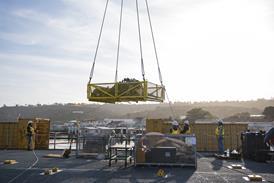Max Kingsley-Jones/LONDON Paul Lewis/WASHINGTON DC
Boeing has dismissed Airbus Industrie's 15-20% cost saving target for the A3XX over the 747-400 as unachievable. The European consortium claims to be ahead of the targets, as its US rival focuses on cheaper 747-based growth derivatives rather than an all-new design to meet its less optimistic ultra-large aircraft demand forecast.
Speaking at a Commercial Aviation Report conference in Washington DC, Airbus vice-president of forecasting and planning Adam Brown said: "The airlines are saying we need to offer 15-20% improved DOCs [direct operating costs per seat] to the 747-400." He said Airbus is ahead of its targets. "We're running at the moment at 17% for the 555-seat A3XX-100 and 23% for the 656-seat -200." Airbus has delayed the A3XX programme once because it was not satisfied that it would reach the cost saving targets on which the launch is understood to be contingent.
Speaking during a briefing in London, Boeing's vice-president marketing, Randy Baseler, dismissed the Airbus claim as all but impossible. He revealed that Boeing's proposed 500-seat 747-based derivative would offer DOC savings of about 7-8% over the 747-400 and better seat-kilometre costs than those of the A3XX. "We don't think Airbus will get near a 20% DOC reduction, but it's good to have targets," he said. "We think they'll struggle to achieve even 15%, unless they discover some revolutionary technology."
Boeing has detailed plans for a two-pronged 747-400-based family which would feature an enlarged wing and more powerful engines, either derivatives of the 747's existing powerplants, or a new design such as the Engine Alliance GP7000. The baseline 747-400X would seat 430 passengers, with a range of 16,100km (8,700nm), while the 500-seat -400X Stretch will have a range of 14,430km.
The two models would be cheaper to introduce than the A3XX, says Baseler, due to high commonality with the 747-400, and would have solid residual value performance. "We are not formally offering these aircraft to airlines yet, and will only launch when we have commitments," he says. He adds that deliveries could begin as early as 2003/4, earlier than previously proposed.
Boeing's latest market forecast, published early this year, continues to cast a pessimistic view of the large airliner market for the next 20 years, with demand estimated at 930 aircraft (570 400/500-seaters and 360 of over 500 seats). Airbus' latest analysis continues to be bullish, with demand for 400-plus seaters put at 1,200 aircraft, plus 300 freighters (Flight International, 30 June-6 July).
Boeing predicts that route fragmentation will increase with the creation of more than 300 new city pairs worldwide over the next 20 years. This will mitigate against the expansion of fleets of very large aircraft, it says, whereas Airbus feels that infrastructure constraints such as airport/airway congestion will make ultra-large aircraft necessary.
Source: Flight International























